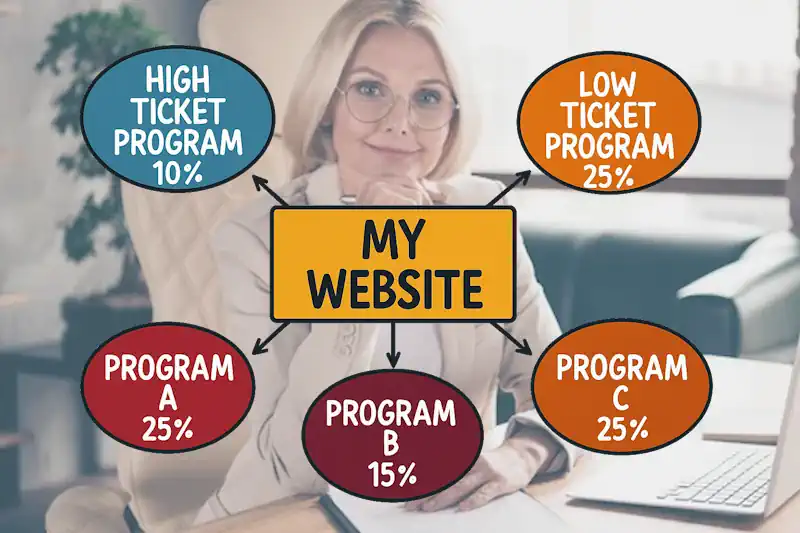Have you ever heard the saying “don’t put all your eggs in one basket”? This timeless advice applies perfectly to affiliate marketing.
 As someone who’s navigated the ups and downs of this industry for years, I can tell you that depending on just one affiliate program for your income is like building your house on shifting sand. Let me show you why diversification isn’t just smart—it’s essential for long-term success in the affiliate marketing world.
As someone who’s navigated the ups and downs of this industry for years, I can tell you that depending on just one affiliate program for your income is like building your house on shifting sand. Let me show you why diversification isn’t just smart—it’s essential for long-term success in the affiliate marketing world.
The Hidden Dangers of Single-Program Dependency
When you’re seeing consistent commissions from one program, it’s tempting to focus all your energy there. The payouts are reliable, the products convert well, and everything seems perfect. But this comfort can be deceptive.
Think of your affiliate business like a table. A table with one leg might stand temporarily, but it’s inherently unstable. One small push and everything comes crashing down. Similarly, relying on a single affiliate program puts your entire business at risk.
Unpredictable Terms and Conditions
One of the most frustrating aspects of affiliate marketing is the lack of control. Affiliate companies typically reserve the right to change their terms whenever they want, without consulting you first.
They might decide to slash commission rates, reduce cookie durations from 30 days to 24 hours, or implement stricter qualification rules. These changes can happen overnight, potentially cutting your income dramatically without warning.
Financial Instability and Business Closures
Companies fail—it’s an unfortunate reality of business. When an affiliate program’s parent company experiences financial difficulties, affiliate payments are often the first expense they’ll delay or eliminate.
If you’re owed substantial commissions when a company goes under, recovering that money can be nearly impossible. Legal action typically costs more than the owed commissions, leaving you with losses you can’t recoup.
Ownership Changes and Program Discontinuations
Let me share a somewhat personal experience that drove this lesson home for me. A friend had built a site that was generating a consistent $800 monthly income. The catch? $500 of that revenue—a whopping 62.5%—came from promoting a single product through one affiliate program.
Then disaster struck. The company was acquired, and the new owners promptly discontinued the affiliate program. Just like that, two-thirds of his monthly revenue from that site vanished overnight. No warning, no transition period—just gone.

What Industry Data Tells Us About Diversification
This isn’t just anecdotal advice. The data backs it up, too. According to research, successful affiliate marketers who consistently earn $10,000+ monthly typically utilize at least three different affiliate networks.
These top performers understand that diversification isn’t just about risk management—it’s about creating multiple growth opportunities and income streams that can complement each other.
The Compound Effect of Multiple Programs
When you work with multiple affiliate programs, you’re not just reducing risk—you’re potentially increasing your overall earnings. Different programs offer varying commission structures, product types, and promotional opportunities that can work synergistically.
For example, you might promote high-ticket items with lower conversion rates through one program while balancing that with higher-converting but lower-commission products from another. This creates a more stable and potentially more lucrative income stream.
Strategic Approaches to Affiliate Diversification
Diversifying your affiliate partnerships doesn’t mean randomly signing up for dozens of programs. A thoughtful, strategic approach is required to build a resilient affiliate business.
Complementary Product Selection
Look for affiliate programs that offer products or services that complement each other rather than compete directly. This allows you to create content that naturally recommends multiple affiliated products as part of a solution for your audience.
For instance, if you run a fitness blog, you might promote workout equipment through one program, nutritional supplements through another, and fitness apparel through a third, creating a comprehensive ecosystem of recommendations.
Building Your Backup Network
Even if you’re currently focused on one high-performing program, always have backup options ready. Here’s how to prepare:
- Research and join alternative programs in your niche
- Test these programs with a small portion of your traffic
- Maintain relationships with affiliate managers across multiple networks
- Keep promotional materials and links updated for quick pivoting if needed
- Regularly evaluate new affiliate opportunities as they emerge
This proactive approach means you won’t be starting from zero if your primary program suddenly changes or disappears.

Balancing Quality and Quantity in Affiliate Partnerships
While diversification is crucial, quality should never be sacrificed for quantity. Each program you promote should meet certain standards to protect your reputation and ensure sustainable income.
Evaluating Potential Affiliate Programs
Before adding a new affiliate program to your portfolio, consider these factors:
- Product quality and relevance to your audience
- Commission structure and payment reliability
- Cookie duration and attribution model
- Company reputation and financial stability
- Quality of affiliate support and marketing materials
Remember that each product you recommend reflects on your personal brand. One poor-quality affiliate product can damage the trust you’ve built with your audience, affecting conversions across all your programs.
Practical Steps to Implement Diversification Today
Ready to strengthen your affiliate business through diversification? Here are actionable steps you can take immediately:
Audit Your Current Affiliate Mix
Start by analyzing your current situation. Calculate what percentage of your income comes from each affiliate program. If any single program accounts for more than 40% of your revenue, that’s a red flag indicating over-dependence.
Next, identify gaps in your current offerings. Are there complementary products your audience needs that you’re not currently promoting? These gaps represent opportunities for new affiliate partnerships.

Research and Test New Programs
Once you’ve identified potential new affiliate programs, implement a testing strategy. Allocate a small portion of your traffic or content to these new partnerships to evaluate their performance before scaling up.
Track key metrics like conversion rates, average commission values, and overall program reliability. This data-driven approach helps ensure you’re adding quality programs to your portfolio.
Building a Resilient Affiliate Business
Diversification isn’t just a defensive strategy—it’s the foundation of a sustainable, growing affiliate business. By spreading your efforts across multiple quality programs, you protect yourself from sudden changes while potentially increasing your overall income.
Remember my friend’s story of losing 62.5% of his revenue overnight? That taught him (and me!) the importance of never becoming too dependent on a single income source. Today, my affiliate business is structured to ensure no single program accounts for more than 25% of total revenue.
The most successful affiliate marketers understand that this business is ultimately about creating value for your audience while building a stable foundation for yourself. Diversification helps you achieve both goals.
Have you experienced the impact of over-reliance on a single affiliate program? Share your story in the comments below—your experience might help fellow marketers avoid similar pitfalls!
